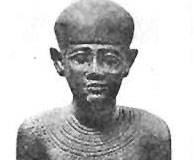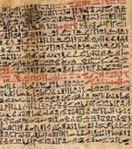Just What the Doctor Ordered in Ancient Egypt
By Ilene Springer
The place: Thebes. The time: Two thousand BC. Youre an Egyptian scribe, on assignment for an important vizier, preparing to take account of various supplies that have just come down (up) the Nile. And what do you have? A terrible, throbbing toothache. Whats the answer? Mashed garlic in a solution of equal parts of vinegar and water.

Or youre an Egyptian wife preparing for a big banquet at your home. All is ready: the cooked geese, the fresh mango, the newly plucked lotus blossoms out of the pond. And what do you have? The start of a scratchy sore throat. Whats the answer? A rinse or gargle with garlic and water/vinegar.
Garlic was an important healing agent to the ancient Egyptians just as it still is today to the modern Coptic Egyptians and to people in all Mediterranean countries. In fact, you could think of garlic as the aspirin of the ancient Egypt.
Medical advances in ancient times
The Egyptians can claim credit for yet another achievement that influences us today: one of the first populations to have practicing physicians. Doctors in Egypt usually went through years of hard training at temple schools in the Various arts of interrogating the patient, inspection or examination, palpation and treatment.

We cannot talk about ancient Egyptian medicine without speaking of the worlds earliest recorded physician, Imhotep, the prime minister of Zosers reign (founder of the Third Dynasty) and also chief architect of the first pyramid at Saqqara. He was renown as a great healer, and centuries after his death he was worshipped as a god of medicine. Today, a statue of Imhotep stands in the Hall of Immortals at the International College of Surgeons in Chicago. Peseshet was the first known female physician in the world, practicing during the Fourth Dynasty. Says Sameh M. Arab, MD, Associate Professor of Cardiology, Alexandria University in Egypt, "Peseshet was titled Lady Overseer of the Lady Physicians and supervised a corps of ladies who were qualified physicians, not midwives. She graduated midwives at the periankh (medical school) of Sais."

Dr. Sameh M. Arab, M.D.
The Egyptians started practicing medicine very early, around 4000 BC, during what is known as the Badarian times--before Egypt was a united nation. For example, evidence from this time period suggests that the green eye paint, malachite, was used to prevent a certain parasitic eye disease.
Egyptian medical practitioners knew a lot about the human body without the modern advantages of X-rays and CAT scans. Their knowledge came primarily through the process of mummification in which they removed and examined different parts of the body after death. They knew about the various fluids of the brain, the exact location of the heart and that the arteries were hollow and that blood circulated throughout the body.
But the Egyptian physicians were also excellent observers of their patients. They knew by the way an individual moved if he was suffering from a dislocated vertebrae. They knew that the urine of a pregnant woman germinated certain grains more rapidly than urine from a non-pregnant woman, according to Dr. Arab.
There were also specialists. There is archaeological evidence of an early dentists skill from the Fourth Dynasty. The mandible of the poor suffering patient was found in which a modern day-like process was used to drain an abscess under the first molar. From tombstones, we also learn about physicians who call themselves palace eye physician, palace stomach bowel physician and even guardian of the anus, according to Professor Hamed A. Ead of the University of Cairo, Giza. There were also physicians who dealt with the medical conditions of womens fertility, pregnancy and contraception.
Written proof
The main sources for our knowledge of ancient Egyptian medicine comes primarily from seven papyri that date from the Twelfth Dynasty to the Twentieth (2000 to 1090 BC). But these archives themselves reveal a much earlier practice of medicine back to the Old Kingdom.

Elbers

Smith Papyrus
The most famous of the papyri are the Smith Papyrus and the Elders, named after their discoverers and interpreters. The Elbers roll is over 20 meters long and 30 centimeters high. It contains 877 recipes concerning a whole host of diseases and symptoms, including that of the eye, skin, head and face; surgical procedures; diseases of women and even comments on housekeeping. Spells are recommended in only twelve cases and in the remainder, the therapy seems quite appropriate to the condition. The Elbers Papyrus is virtually a medical treatise on all known medical interventions at the time, one of the earliest ever written, over 36 centuries ago!
The Edwin Smith Papyrus much shorter and is actually a copy of a much older document dating back to probably the Old Kingdom. The most important part is the ancient authors addition of a whole series of glossaries which explain obsolete terms used when the papyrus was first written. The Smith Papyrus also discusses actual cases dealing with wounds, each concentrated in different regions of the body---the head, throat and neck, sternum, and spinal column.
The office visit in ancient Egypt
Lets say youre a citizen of ancient Egypt and suffering from cystitis, a recurring, very painful type of urinary tract condition. What happens with the doctor? Probably the doctor would make a home visit if you could afford it. The first thing he might do is examine your pulse, although it was never really clear what information the ancient Egyptians learned from this procedure.

A Relief of What is Thought to be Surgical Instruments
Then your physician would interrogate you, according to the Smith Papyrus, finding out about your general condition and symptoms, just as doctors do today, but probably a bit longer than the restricted fifteen minutes. The doctor might ask you if you had any enemies or did anything recently to incur anyones wrath. If you thought so, he might chant a spell to help rid the entity that was causing your cystitis. Or give you an amulet or healing charm to wear.
Then the doctor would examine you with a lot of hands-on observation, probing here, palpating there. He might ask for an urine sample to look at or test when he left your bedside. Finally, he would pronounce what he thought was wrong with you and what your treatment should be. In your case, it would not be surprising if the doctor ordered you to take the herb coriander, still used today for medicinal purposes by the Egyptian Copts. You would be instructed to make the leaves into a tea, which was known to soothe a variety of stomach and urinary ailments, including cystitis. Coriander seeds, in fact, were discovered in the tomb of Tutankhamun and in other ancient burial sites.
The ancient Egyptians were the prototype of the holistic health practitioner. They treated the whole person: physically, mentally, spiritually and even socially. Many of the medicinal herbs we use today were first used by the ancient Egyptians. Much of our knowledge of anatomy was handed down to us by these ancient healers from their experience with mummification. And the doctor back in ancient Egypt, although lacking in our high tech medical equipment, seemed to recognize a very important thing we may have forgotten: how important it is to listen to your patient.
###
Ilene Springer writes on ancient life in Egypt and Israel. She is a student of museum studies at Harvard University.
Sources
On the Web:
http://www.levity.com/alchemy/islam22.html
Ancient Egyptian Medicine by John F. Nunn
London, 1966
ISBN: 0-7141-1906-7
Last Updated: June 6th, 2011
|